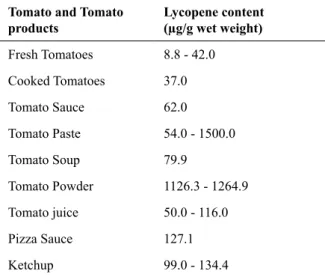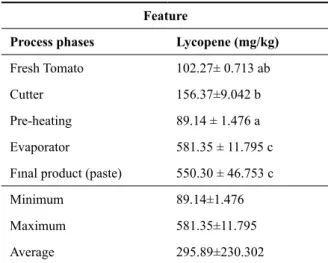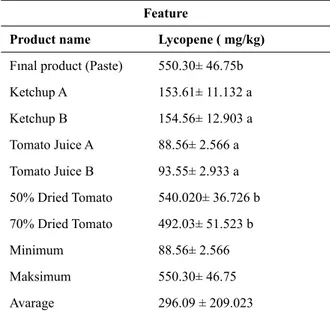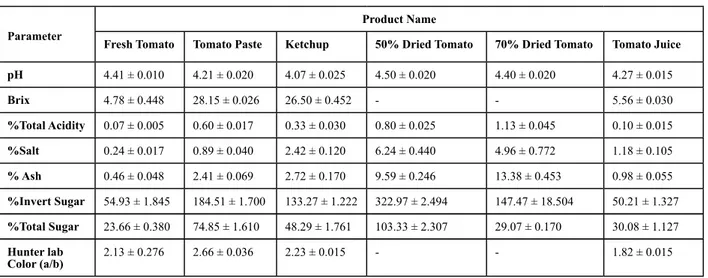1. Introduction
Tomato is one of the mostly produced vegetables both in Turkey and in the World [1]. Although almost all vegetables have health - protecting and healing properties for humans due to their nutritional components, some species are more prominent than others. Tomato is one of the leading species in this regard [2].
It has been reported that foodstuffs contain proteins, carbohydrates, oils, minerals and vitamins, along with one and/or many of antioxidant substances
[3]. Lycopene is the most prevalent carotenoid in tomato and constitues about 83% of the pigments in tomato [4].
Lycopene, like all carotenoids, is derived from the acyclic C40H56 structure [5]. Lycopene is a powerful antioxidant and main component of the red color of tomato. Lycopene level in a tomato may vary according to fruit variety, maturity stage and growing conditions [6]. Lycopene content of fresh tomato and some tomato products are given in Table 1 [7].
THE EFFECT OF PROCESSING TECHNOLOGIES ON
LYCOPENE IN TOMATOES (Lycopersicon esculentum L.)
Nahide TÜRÜT
1, Güner ARKUN
2*Abstract
Lycopene is a natural pigment of carotenoid family and recent years there is an increasing interest for the health benefits of lycopene. Tomato and tomato products are considered as one of the most important source of lycopene. The aim of this study is to determine the amount of lycopene in different tomato products such as fresh tomatoes, ketchup, tomato juice, dried tomatoes and tomato paste. It is also aimed to determine the effect of tomato paste processing on lycopene. In this study, lycopene values were found in the range of 89.14 - 581.35 mg/kg during processing at 5 different stages. The ranking of lycopene values found to be as follows: evaporator ˃ the final product (tomato paste) ˃ shredder ˃ fresh tomatoes ˃ preheating stage. Lycopene amount was low (89.14 ± 1.476 mg/kg) at preheating stage, while the highest lycopene value was found at evaporation stage (581.35 ± 11.795 mg/kg). Among all the examined tomato products, lycopene values were found in the range of 88.56 - 550.30 mg/kg in the order of : The final product (tomato paste) ˃ 50% dehydrated tomato ˃ 70% dehydrated tomato ˃ ketchup ˃ tomato juice. Tomato juice found to have low lycopene (88.56± 2.566 mg/kg), while the final products of tomato paste have the highest value (550.30 ± 46.75 mg/kg). In addition, some the quality properties of the products have also been examined and the following results were obtained: Soluble dry matter 28.01 – 28.27 °Brix, pH 4.06 – 4.52, total acidity 0.07 – 1.13g/100g, ash 0.41 – 13.38 %, color (a/b rate) 1.82 – 2.45, viscosity 3.57 – 4.03, invert sugar at total dry matter 42.29 – 322.97%; and black spot 0 /10g. Considering the quality parameters of all samples, it was determined that the result of chemical and physical analyses were in conformity with values defined in Turkish Standards (TS 1466 Tomato Paste - Puree, TS 5282 Ketchup, TS 1595 Tomato juice and TS 3926 Dehydrated Tomatoes)
Keywords: Tomatoes, lycopene, antioxidant activity, tomato products
1 Istanbul Aydın University, Engineering Faculty, Department of Food Engineering Istanbul TURKEY,
nahideturut@stu.aydin.edu.tr
2* Istanbul Aydın University, Engineering Faculty, Department of Food Engineering Istanbul TURKEY,
Table 1. Lycopene content of tomato and tomato
products [7]
Tomato and Tomato
products Lycopene content (µg/g wet weight)
Fresh Tomatoes 8.8 - 42.0 Cooked Tomatoes 37.0 Tomato Sauce 62.0 Tomato Paste 54.0 - 1500.0 Tomato Soup 79.9 Tomato Powder 1126.3 - 1264.9 Tomato juice 50.0 - 116.0 Pizza Sauce 127.1 Ketchup 99.0 - 134.4
Various foods may contain varying amounts of lycopene according to the agricultural methods used, processing and preservation technologies and different cooking methods. Thus, various food composition databases may define the lycopene content at different values for fresh tomatoes varieties, tomato sauce, ketchup, dried tomatoes, tomato paste, etc. [8].
Carotenoids that are locked in a food matrix are being released during food processing especially heat treatments and their bioavailability is also increased. Cooking or other heat treatments that the foods are subjected might break the cell walls of tomatoes and neutralize the binding forces between lycopene and the fruit tissue for lycopene to be more easily available [9].
Thus, the best lycopene sources are suggested to be cooked tomatoes and tomato products [10,11]. In terms of its bioavailability, lycopene in tomato paste was determined to be 2.5 times higher than the lycopene in fresh tomatoes.
Various studies reported that different antioxidant compounds in diet may be effective in preventing cancer by reducing oxidative stress. Lycopene is one of the heavily studied carotenoids in terms of reducing cancer risk [12]. Carotenoids, especially
lycopene, slow down tumor growth by increasing the communication between healthy cells. Lycopene has antioxidant effects and regularly acts against free oxygen radicals that cause DNA damage and cancer in the body [13].
Since carotenoids are transported through low density lipoproteins (LDL), they reduce cardiovascular disease risks by preventing LDL’s exposure to oxidation [14]. Lutein and zeaxanthin in the eye retina protect the eye from the harmful effects of free radicals and light [15] and prevent the formation of cataracts and age-dependent macula disorders [16].
In this study the lycopene content in different tomato products were determined and discussed for a healty nutrition. In addition, the effect of tomato paste processing on lycopene in fresh tomato was also studied through in plant applications in a tomatopaste processing plant.
2. Materials and Methods 2.1. Materials
Samples to be used as material were obtained from a national tomato paste manufacturing plant that produces commercial tomato paste. The tomato variety subjected to processing in the tomatopaste processing plant was Rio Grande grown in Bursa region, Turkey.
Totally 15 samples were taken from 3 batches of tomato paste processing stages. Two ketchup samples (manufactured under laboratory conditions), two tomato juice samples and two half-dried tomato samples (sun dried) were obtained for examination. Tomato paste and ketchup samples were taken in ~830 gr sterile glass jars, tomato juices in 1 liter glass package and dried tomato samples in 1 kg vacuum plastic packages. The samples consist of products grown and manufactured in August 2015 and the study was conducted in triplicate and the results are reported accordingly.
Samples were stored under cold conditions at +4°C until the analyses performed.
2.2. Methods
The methods of analyses conducted on the samples are given below.
Lycopene Determination:
Three samples were taken from each sample for lycopene analysis.
Lycopene determination was conducted according to Anon.,1983 [21] and Anon., 1990 [20]. UV-VIS spectrophotometer (Optizen Pop, Korea) was used for the measurements.
The samples were prepared to be measured by the spectrophotometer after the extraction process. In extraction, water:aseton (1:1, v/v) solution was used after boiling, the solution was centrifuged and separated using petroleum ether in a separatory funnel, petroleum phase was collected.
Petroleum ether was used as blank in spectrophotometric measurements. A UV-VIS spectrophotometer (Optizen Pop, Korea) was used at 505 nm wavelength (A505), and the absorbance values were measured. The lycopene amount was calculated by using the absorbance value measured in the formula in (2.1).
Lycopene (µg/g) or (mg/kg) = (2.1)
Here;
V= The final volume of the solution (ml), W= Amount of sample (g),
(A505): Absorbance at 505 nm , (Anonim,1983; T.O.K.B., 1988).
The other analyses were performed according to the methods of analyses defined in Turkish Standards (TS 1466 Tomato Paste - Puree, TS 5282 Ketchup, TS 1595 Tomato juice and TS 3926 Dehydrated Tomatoes).
Statistical Methods
The analysis was conducted in triples and the results are presented as arithmetic average ±
standard error of average. In order to statistical evaluation of the results of lycopene content, SPSS Windows software (IBM SPSS Statistics 23, 2015) with one-way ANOVA method was used. Post Hoc tests were also used in order to determine the cause of difference between the averages; Tukey multiple comparison test was used when the variances are homogenous, and Games Howel, Tamhane’s T2 was used when they were not. Averages that do not show the same letter in the tables are found to be statistically different.
3. Results
The amounts of lycopene were determined in fresh tomato, in samples of different tomato paste processing stages and in different tomato products. The results of analyses were evaluated statistically. Lycopene values for samples that represent different tomato paste process phases are given in Table 2, Figure 1. The figure with the same letter mean that there is no statistically significant difference in terms of lycopene contents.
Table 2. Changes in lycopene content during
tomato paste processing *
Feature
Process phases Lycopene (mg/kg)
Fresh Tomato 102.27± 0.713 ab
Cutter 156.37±9.042 b
Pre-heating 89.14 ± 1.476 a
Evaporator 581.35 ± 11.795 c
Fınal product (paste) 550.30 ± 46.753 c
Minimum 89.14±1.476
Maximum 581.35±11.795
Average 295.89±230.302
*: The difference between the general properties of process phases that have different letters in the same column is significant (p<0.05).
The lycopene values show that the pre-heating phase of tomato has a low lycopene value (89.14 ± 1.476 mg/kg) and is significantly different (p<0,05)
from other phases, except the fresh tomato phase. The highest lycopene content was determined in evaporation phase (581.35 ± 11.795 mg/kg) and it is significantly different (p<0,05) from other phases, except for the tomato paste . The lycopene values were determined for fresh tomato in the range of 8,8 - 42,0 µg/g, for preheating stage at a value of 37,9 µg/g, and for tomato paste 54-1500 µg/g [7].
Figure 1. Lycopene content in tomatoes during
tomato paste processing
The lycopene values for all tomato products are given in Table 3.
Table 3. Statistical results for lycopene content of
all tomato products
Feature
Product name Lycopene ( mg/kg)
Fınal product (Paste) 550.30± 46.75b
Ketchup A 153.61± 11.132 a Ketchup B 154.56± 12.903 a Tomato Juice A 88.56± 2.566 a Tomato Juice B 93.55± 2.933 a 50% Dried Tomato 540.020± 36.726 b 70% Dried Tomato 492.03± 51.523 b Minimum 88.56± 2.566 Maksimum 550.30± 46.75 Avarage 296.09 ± 209.023
*: The difference between the general properties of process phases that have different letters in the same column is significant (p<0.05).
The lycopene values show that tomato juice has low lycopene value (91.06 ± 2.749 mg/kg) and exhibits a statistically significant difference (p<0,05) from other products except for ketchup. The highest amount of lycopene was determined in the final product (tomato paste) (550.30 ± 46.75 mg/kg), and is significantly different (p<0,05) from other products except for 50% dried tomato and 75% dried tomato.
The lycopene contents were determined as 30.25, 159.16, 293.3, 170.08 and 96.6 mg/kg in fresh tomato, tomato paste, triple concentrated tomato paste, ketchup and tomato juice, respectively. [17]. The lycopene amounts of dried tomato products were found in the range of 500-700 mg/kg [18], while it has been determined as 659.5 mg/kgin tomato paste [19]. Lycopene contents of all tomato products are given in Figure 2.
Figure 2. Lycopene content of tomato products
In tomato paste processing, tomatoes at the pre-heating process have a low lycopene value (89.14 ± 1.476 mg/kg), while the evaporator phase has the highest lycopene content (581.35 ± 11.795 mg/ kg).
Among all tomato products,the lowest lycopene value was determined in tomato juice (88.56± 2.566 mg/kg) while tomato paste has the highest amount of lycopene (550.30 ± 46.75 mg/kg). In addition to lycopene content, some quality parameters of the products were also investigated. The statistical results of the quality specifications for all products are given in Table 4.
Parameter
Product Name
Fresh Tomato Tomato Paste Ketchup 50% Dried Tomato 70% Dried Tomato Tomato Juice
pH 4.41 ± 0.010 4.21 ± 0.020 4.07 ± 0.025 4.50 ± 0.020 4.40 ± 0.020 4.27 ± 0.015 Brix 4.78 ± 0.448 28.15 ± 0.026 26.50 ± 0.452 - - 5.56 ± 0.030 %Total Acidity 0.07 ± 0.005 0.60 ± 0.017 0.33 ± 0.030 0.80 ± 0.025 1.13 ± 0.045 0.10 ± 0.015 %Salt 0.24 ± 0.017 0.89 ± 0.040 2.42 ± 0.120 6.24 ± 0.440 4.96 ± 0.772 1.18 ± 0.105 % Ash 0.46 ± 0.048 2.41 ± 0.069 2.72 ± 0.170 9.59 ± 0.246 13.38 ± 0.453 0.98 ± 0.055 %Invert Sugar 54.93 ± 1.845 184.51 ± 1.700 133.27 ± 1.222 322.97 ± 2.494 147.47 ± 18.504 50.21 ± 1.327 %Total Sugar 23.66 ± 0.380 74.85 ± 1.610 48.29 ± 1.761 103.33 ± 2.307 29.07 ± 0.170 30.08 ± 1.127 Hunter lab Color (a/b) 2.13 ± 0.276 2.66 ± 0.036 2.23 ± 0.015 - - 1.82 ± 0.015
It was determined that mean values of all samples investigated were in conformity with the legal limits specified by Turkish Standards (TS 1466 Tomato Paste - Puree, TS 5282 Ketchup, TS 1595 Tomato juice and TS 3926 Dehydrated Tomatoes)
4. Conclusion
The main objective of the study is determining the lycopene content in various tomato products and also the change in lycopene content during tomato paste production. It has been determined that lycopene values vary between 89.14 and 581.35 mg/kg during tomato paste production stages. The products can be sorted for lycopene contents from high to low values during tomato paste processing: Evaporator > Final product (paste) > Cutter > Fresh Tomato > Pre-heating. Considering all the tomato products, the lycopene amounts were in the range of 88.56 and 550.30 mg/kg and . The ranking for lycopene of all tomato products: Tomato paste > 50% dried tomato > 70% dried tomato > ketchup > fresh tomato > tomato juice. In processed tomato products, heat treatment of tomato breaks down the cell walls due to heat effect and lycopene is released. Thus, the lycopene concentration in heat-treated tomato products is higher than fresh tomato. Release of lycopene occurs when it dissolved from the fruit tissue
during processing or cooking and creates a more easily available form. Thus, the best lycopene sources are suggested to be cooked tomatoes and tomato products.
Tomato is very important for humans in terms of health and nutrition. Considering the fact that the second most prevalent cause of death in the world is cancer, it is recognized that nutrition styles have a great role in cancer prevention. It is assumed that 1/3 of all cancers can be prevented through individual diet modification. Lycopene is one of the mostly studied carotenoids in terms of reducing cancer risk in human.
Lycopene protects the cells from the damages by free radicals, strengthens the connection between cells and improves cell metabolism. Its antioxidant properties provide protection against cancer, cardiovascular disorders, eye disorders, ageing, bone and skin issues, and many other disorders. In the light of the various reports on lycopene, lycopene plays an important role in preventing some chronic diseases. Since the tomato and tomato products are the important source of lycopen, tomato and products derived from tomatoes such as pastes, ketchup, tomato juice and dried tomato will help the healty nutrition and well being of the people.
REFERENCES
[1] Günay, A.,2005. Vegetable growing. V:II,
Special Vegetable Breeding, İzmir, 531.
[2] Sönmez, K., ve Ellialtıoğlu, Ş.Ş., 2014. Tomatoes, Carotenoids and A review on factors that affect those. Harvest, 31 (2):107-130. Eskişehir Osmangazi University. Faculty of Agriculture. Department of Horticulture ,Eskişehir. Ankara University Faculty of Agriculture. Department of Horticulture, Ankara. [3] Yılmaz, İ., 2010. Some Foods Containing
Antioxidants and Oxidative Stress. İnönü
University. Faculty of Medicine Journal
17 (2) 143-153.
[4] Gould, W.A., 1983.Tomato Production, Processing and Quality Evaluation. Avi Publishing Company, Inc., Westport, Connecticut.
[5] Bramley PM., Review. Is lycopene beneficial to human health. Phytochemistry. 54(3): 233-6. (2000).
[6] Sahlin, E., Savage, G.P., Lister, C.E., 2004. Investigation of the antioxidant properties of tomatoes after processing. Journal of Food Composition and Analyses. 17:635-647.
[7] Hobson, G., Grierson, D., 1996. Tomato, Biochemistry of Fruit Ripening,
Seymour, G.B., Taylor, J.E. and Tucker, G.A.(Eds), 403-414,Chapman and Hall, London.
[8] Porrini M, Riso P. 2005. What are typical lycopene intakes? J Nutr 135(8):2042S-5S. [9] Omoni, A.O. and Aluko, R.E. 2005. The anti-carcinogenic and anti-atherogenic effects of lycopene a review. Trends
Food Sci. Technol., 16; 344-350.
[10] Benton Jones, J., 2007. Tomato Plant Culture: In the Field, Greenhouse, and Home Garden, Second Edition. CRC Press, 404 pp.
[11] Gartner, C., Stahl, W. and Sies, H. 1997. Lycopene is more bioavailable from tomato paste than from fresh tomatoes. Am. J. Clin. Nutr., 66; 116-122.
[12] Bıçaklı, D.H.,Uslu, R., 2012. Lycopene and Cancer. Ege University Faculty of
Medicine. Turkish onkoloji journal.
27(2):93-97.
[13] Everson KM, and McQueen CE. 2004. Lycopene for prevention and treatment of prostate cancer. Am J Health Syst Pharm;61(15):1562-6.
[14] Duthie, G.G., Wahle, K.W.J. and James, W.P.T. 1989. Oxidants, antioxidants and cardiovascular disease. Nutrition Research Reviews, 2, 51–62.
[15] Deming, D.M. and Erdman, J.W. 1999. Mammalian carotenoid absorption and metabolism. Pure and Applied
Chemistry, 71, 2213–2223.
[16] Sommerburg, O., Keunen, J.E.E., Bird, A.C. and van Kuijk, F.J.G.M. 1998. Fruits and vegetables that are sources for lutein and zeaxanthin: the macular pigment inhuman eyes. British Journal of Ophtalmology, 82, 907–910.
[17] Matulka, R.A., Hood, A.M., Griffıths, 2004. Safety evaluation of a natural tomato oleoresin extract derived from food-processing tomatoes. Regulatogy and Pharmacology, 39:390-402.
[18] Çernişev, S. ve Şleagun, G. 2007. Influenceof Dehydration Technologies on Dried Tomatoes Biological Quality And Value, Cercetari Agronomice In Moldova
Anul, 3 (131).
[19] Artık, N. 2003. Ergosterol Level in Tomato Paste and Change During Processing. Ankara University. Scientific Research Project Final Report
[20] Anonymous,1990. Akpınar Agricultural Production and Canning A.Ş.(AKFA), Educatıonal Publıcatıons. Balıkesir. [21] Anonymous, 1983. Turkish
Standardization Institute. Food Materials Inspection and Analysis Methods Book, Food Ingredients. Ministry of Agriculture Forestry and Rural Affairs, Food Works. General Directorate. General Broadcast Number: 65, 796 s., Ankara.



